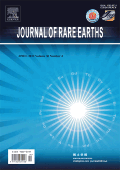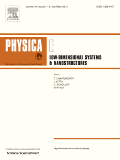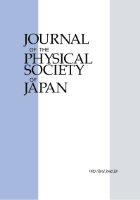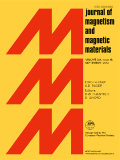
IEEE Magnetics Letters
Scope & Guideline
Connecting Ideas and Innovations in Magnetics
Introduction
Aims and Scopes
- Magnetic Materials Characterization:
Research on the structural, magnetic, and microstructural properties of various magnetic materials, including metals, alloys, and nanostructures. - Spintronics and Magnetic Devices:
Focus on the development and performance evaluation of spintronic devices, including magnetic tunnel junctions (MTJs), spin-orbit torque (SOT) devices, and applications in memory and logic operations. - Magnetic Field Applications:
Exploration of the practical applications of magnetic fields in areas such as medical devices (e.g., transcranial magnetic stimulation) and magnetic particle imaging. - Computational and Theoretical Magnetics:
Utilization of computational models and theoretical frameworks to analyze magnetic behaviors, including micromagnetic simulations and magnetocaloric effects. - Emerging Technologies and Methods:
Investigation of new technologies in magnetics, including machine learning applications, novel fabrication techniques, and innovative measurement methods.
Trending and Emerging
- Spintronics Innovations:
There is a significant increase in research related to spintronics, particularly in the development of spin-based devices that integrate memory and logic functionalities, showcasing the rise of efficient and compact computing technologies. - Magnetic Nanostructures:
Research focusing on magnetic nanostructures and their unique properties is on the rise, driven by their potential applications in high-density storage, data processing, and medical technologies. - Neurotechnology and Magnetic Applications:
Emerging studies on the use of magnetic fields in neurotechnology, including applications in brain stimulation and imaging, are becoming increasingly prevalent, highlighting interdisciplinary research. - Machine Learning in Magnetics:
The application of machine learning techniques to optimize magnetic materials and predict their properties is gaining momentum, representing a fusion of computational techniques with experimental magnetics. - Multifunctional Magnetic Devices:
There is a trend towards developing multifunctional magnetic devices that can serve dual purposes, such as combining sensing and actuation, which aligns with the trend of integrated technologies.
Declining or Waning
- Traditional Ferromagnetic Materials:
Research focused solely on conventional ferromagnetic materials and their basic properties appears to be waning, as the field shifts towards more complex systems and advanced materials. - Static Magnetic Applications:
Studies centered on static magnetic applications, such as traditional magnetic sensors, are less prevalent, with a growing emphasis on dynamic and multifunctional magnetic systems. - Basic Theoretical Models:
While foundational theories remain important, there is a noted decline in papers that solely explore basic theoretical models without application to contemporary technological challenges.
Similar Journals

Progress in Superconductivity and Cryogenics
Exploring the Depths of Cryogenic Science and SuperconductivityProgress in Superconductivity and Cryogenics is a distinguished academic journal published by the Korea Institute of Applied Superconductivity & Cryogenics, dedicated to advancing the field of superconductivity and cryogenic technologies. Since its inception in 2009, this journal has served as a pivotal platform for researchers and practitioners, promoting the dissemination of innovative findings and methodologies. Although currently positioned in Q4 quartiles in both Electrical and Electronic Engineering and Electronic, Optical and Magnetic Materials, the journal continually strives for excellence, offering insights that are essential for understanding the complexities of superconducting materials and their applications. While currently not an open-access journal, it provides invaluable research to the global scientific community. The journal's address is located in Changwon, South Korea, and aims to bridge the gap between theoretical research and practical implementation, making it a crucial resource for those engaged in the vibrant study of superconductivity.

JOURNAL OF RARE EARTHS
Illuminating the Path of Rare Earth ExplorationThe JOURNAL OF RARE EARTHS, published by Elsevier, stands as a premier outlet for cutting-edge research in the fields of chemistry and geochemistry, particularly focusing on rare earth elements and their diverse applications. Since its inception in 1993, this esteemed journal has gained significant recognition, achieving a Q1 ranking in Chemistry (Miscellaneous) and a Q2 ranking in Geochemistry and Petrology as of 2023. With a strong position in the Scopus rankings—placing 12th out of 154 in Earth and Planetary Sciences and 69th out of 408 in General Chemistry—this journal is pivotal for scientists and industry professionals seeking to advance their understanding and application of rare earths. Although it is not an open-access publication, access to its comprehensive articles and reviews can be gained through institutional subscriptions, ensuring that valuable research continues to reach a targeted audience. The JOURNAL OF RARE EARTHS is committed to fostering scientific dialogue and innovation, making it an essential resource for researchers, educators, and students alike.

INTERNATIONAL JOURNAL OF APPLIED ELECTROMAGNETICS AND MECHANICS
Empowering Researchers to Shape the Future of EngineeringINTERNATIONAL JOURNAL OF APPLIED ELECTROMAGNETICS AND MECHANICS (ISSN: 1383-5416, E-ISSN: 1875-8800) is a prominent peer-reviewed journal published by IOS PRESS, based in the Netherlands. Since its inception in 1996, the journal has established itself as a vital resource for researchers, professionals, and students in the interdisciplinary fields of applied electromagnetics and mechanics, covering a broad spectrum of topics including mechanical engineering, electrical and electronic engineering, as well as condensed matter physics. Although it currently operates under a subscription model, its accessibility and relevance are underscored by its rankings in Scopus across several categories: notably, it ranks in the 34th percentile in Mechanical Engineering and 31st in Electrical and Electronic Engineering. With convergence anticipated until 2024, the journal aims to foster innovative research, promote interdisciplinary collaboration, and provide a platform for the latest advancements in electromagnetics and mechanics, thereby contributing significantly to the academic community and industry practices.

Journal of Superconductivity and Novel Magnetism
Innovating the Future of Magnetic PhenomenaJournal of Superconductivity and Novel Magnetism, published by SPRINGER, is a premier venue for research in the dynamic fields of condensed matter physics and materials science. With an ISSN of 1557-1939 and an E-ISSN of 1557-1947, this journal provides an essential platform for disseminating innovative studies examining the complexities of superconductivity and magnetic phenomena. The journal is recognized for its contributions, holding a Q3 quartile ranking in both condensed matter physics and electronic, optical, and magnetic materials as of 2023. With a commitment to rigor and relevance, it features research that breaks new ground in understanding the properties and applications of superconducting materials, aiming to bridge fundamental science with technological advancements. Despite its lack of open access, the journal remains pivotal for researchers, professionals, and students keen to stay abreast of cutting-edge developments in the field, making it an indispensable resource for cultivating knowledge and promoting collaboration.

Journal of the Korean Magnetics Society
Exploring innovations in magnetic materials and applications.Journal of the Korean Magnetics Society, published by the Korean Magnetics Society, is a prestigious academic journal dedicated to advancing the field of magnetics. Renowned for its contributions to both fundamental and applied magnetics research, this journal spans a wide range of topics, including magnetic materials, magnetometry, and applications in technology. Aimed at researchers, professionals, and students, it serves as a vital platform for disseminating high-quality research and innovative findings within the magnetics community. Although it does not currently offer Open Access options, the journal maintains a high academic standard, supported by its commitment to rigorous peer review processes. Its ISSN 1598-5385 and E-ISSN 2233-6648 ensure that it is easily traceable within academic databases, promoting continuous engagement and scholarship in the disciplines of physics and engineering related to magnetic phenomena. Whether you are looking to publish cutting-edge research or stay abreast of the latest discoveries in magnetics, the Journal of the Korean Magnetics Society is an indispensable resource.

PHYSICA E-LOW-DIMENSIONAL SYSTEMS & NANOSTRUCTURES
Exploring the innovative realm of low-dimensional systems.PHYSICA E-LOW-DIMENSIONAL SYSTEMS & NANOSTRUCTURES, published by ELSEVIER, is a premier journal dedicated to advancing the field of condensed matter and nanoscience, focusing on the innovative properties and applications of low-dimensional systems. With an esteemed Q2 ranking in multiple categories including Atomic and Molecular Physics, Condensed Matter Physics, and Nanoscience for 2023, this journal serves as a vital platform for researchers and professionals aiming to disseminate and discuss cutting-edge research. Established in 1974 and converging its focus from 1997 onwards, PHYSICA E captures the evolving landscape of material science, making it a crucial resource for anyone invested in the dynamics of electronic, optical, and magnetic materials. Although the journal operates on a subscription basis, its broad accessibility and significant placement within Scopus rankings—such as being in the 83rd percentile for Condensed Matter Physics—underscore its importance within the academic community. Researchers and students alike will find this journal a cornerstone for fostering knowledge and collaboration in the fields of nanotechnology and low-dimensional physics.

MAGNETIC RESONANCE MATERIALS IN PHYSICS BIOLOGY AND MEDICINE
Advancing the Frontiers of Magnetic Resonance ResearchMAGNETIC RESONANCE MATERIALS IN PHYSICS BIOLOGY AND MEDICINE, published by SPRINGER, is a premier academic journal dedicated to advancing the fields of biophysics, radiology, and medical imaging. With a strong presence in Germany and an international readership, this journal has established itself as a vital resource for researchers and professionals engaged in the interdisciplinary study of magnetic resonance applications. Featuring a commendable 2023 impact factor and categorized in Q2 quartiles across several domains—including Biophysics and Radiological Technologies—this journal provides a platform for innovative research and practical implementations in the field. Although it does not follow an Open Access model, it offers extensive archives dating back to 1984, affirming its long-standing commitment to scholarly excellence. The journal not only ranks impressively within Scopus metrics, but it also promotes ongoing discourse that bridges gaps between physics, biology, and medicine, making it an essential read for professionals and students aiming to stay informed about cutting-edge developments.

Plasma and Fusion Research
Advancing Knowledge in Plasma Science and Energy SolutionsPlasma and Fusion Research is a pivotal journal within the realm of plasma science and nuclear fusion, published by the Japan Society of Plasma Science and Nuclear Fusion Research. With an ISSN of 1880-6821, this journal serves as a vital platform for disseminating significant research findings and advancements from Japan and around the globe. Operating since 2006, it has steadily contributed to the field, reflected in its recognition as a Q3 journal in Condensed Matter Physics for the year 2023 and its ranking of #383 out of 434 in the Scopus categories, placing it in the 11th percentile. Although it currently does not offer open access, the journal's commitment to quality research makes it essential reading for researchers, professionals, and students keen on exploring the complexities of plasma dynamics, fusion technology, and their applications in energy production. Situated in Nagoya, Japan, the journal fosters a collaborative environment aimed at pushing the boundaries of knowledge in plasma physics and enhancing the understanding of fusion processes.

JOURNAL OF THE PHYSICAL SOCIETY OF JAPAN
Advancing the Frontiers of Physics and AstronomyThe JOURNAL OF THE PHYSICAL SOCIETY OF JAPAN, published by the Physical Society of Japan, has been at the forefront of advancing knowledge in the field of Physics and Astronomy since its inception in 1946. With a commendable reputation reflected in its Q2 ranking within its category for 2023, this journal serves as a vital platform for disseminating high-quality research and innovative concepts. Researchers and professionals alike can engage with cutting-edge studies and reviews that span a diverse range of topics pivotal to the physical sciences. Although the journal does not currently operate with an open access model, it maintains a robust impact on the global physics community, evidenced by its placement in the 59th percentile among a competitive pool of 243 journals. With an unwavering commitment to bridging theory and application, the JOURNAL OF THE PHYSICAL SOCIETY OF JAPAN continues to inspire and cultivate scholarly discourse and collaboration across disciplines.

JOURNAL OF MAGNETISM AND MAGNETIC MATERIALS
Unveiling the Science of MagnetismJOURNAL OF MAGNETISM AND MAGNETIC MATERIALS, published by Elsevier, stands at the forefront of research in the fields of magnetism and magnetic materials. With an established history since 1975 and a commitment to advancing knowledge through rigorous peer-reviewed studies, this journal has become a valuable resource for researchers and academics alike. Housed in the Netherlands and indexed under Scopus, it ranks Q2 in both Condensed Matter Physics and Electronic, Optical and Magnetic Materials, reflecting its impact within these domains. The journal aims to disseminate innovative research findings, methodologies, and reviews pertaining to magnetic phenomena, thus facilitating significant advancements in applications ranging from data storage technologies to medical imaging. While the journal does not feature open access options, it remains a vital part of the scientific dialogue, showcasing content that attracts a diverse audience, including researchers, professionals, and graduate students dedicated to enhancing their understanding of magnetism in various materials.